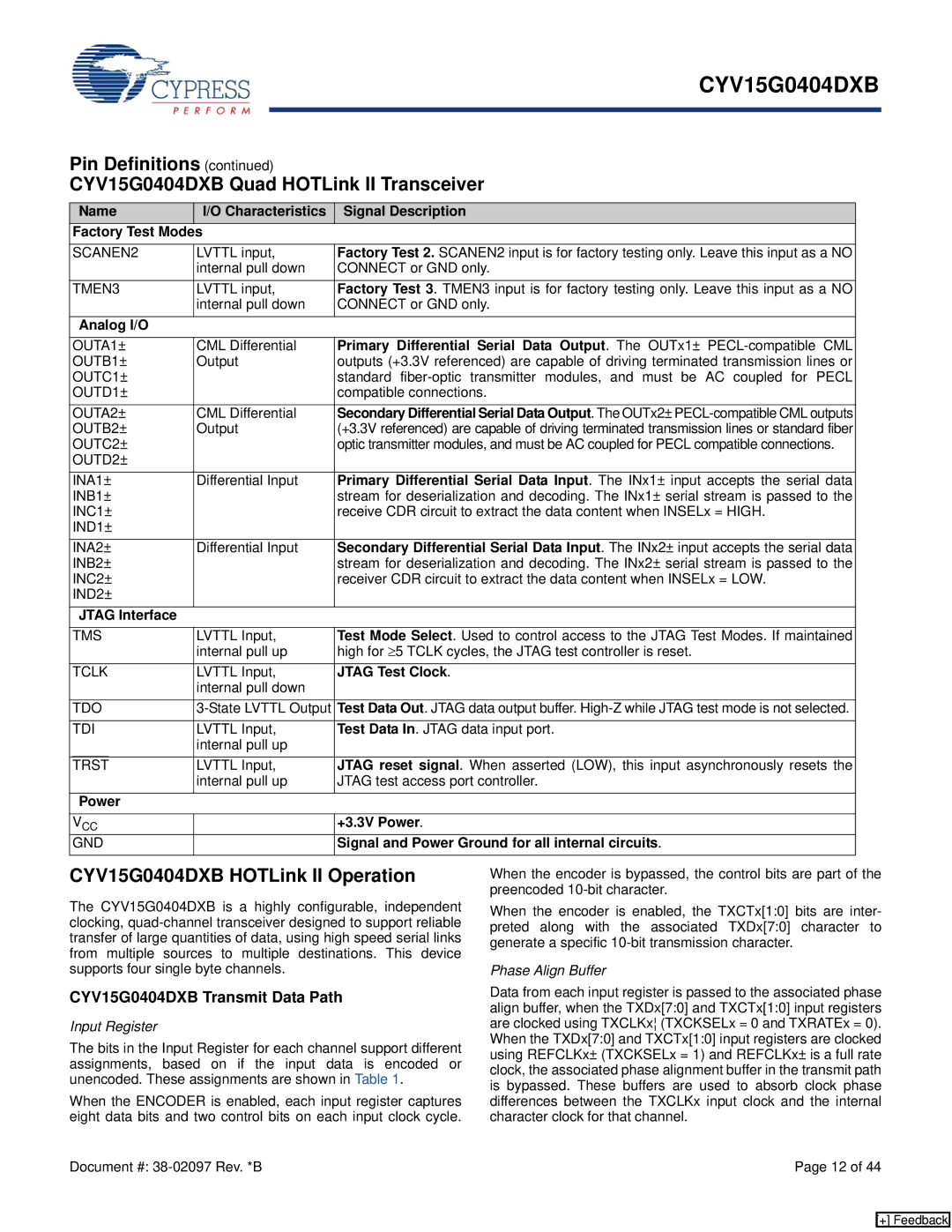
CYV15G0404DXB
Pin Definitions (continued)
CYV15G0404DXB Quad HOTLink II Transceiver
Name | I/O Characteristics | Signal Description |
Factory Test Modes |
|
|
SCANEN2 | LVTTL input, | Factory Test 2. SCANEN2 input is for factory testing only. Leave this input as a NO |
| internal pull down | CONNECT or GND only. |
TMEN3 | LVTTL input, | Factory Test 3. TMEN3 input is for factory testing only. Leave this input as a NO |
| internal pull down | CONNECT or GND only. |
Analog I/O |
|
|
OUTA1± | CML Differential | Primary Differential Serial Data Output. The OUTx1± |
OUTB1± | Output | outputs (+3.3V referenced) are capable of driving terminated transmission lines or |
OUTC1± |
| standard |
OUTD1± |
| compatible connections. |
OUTA2± | CML Differential | Secondary Differential Serial Data Output. The OUTx2± |
OUTB2± | Output | (+3.3V referenced) are capable of driving terminated transmission lines or standard fiber |
OUTC2± |
| optic transmitter modules, and must be AC coupled for PECL compatible connections. |
OUTD2± |
|
|
INA1± | Differential Input | Primary Differential Serial Data Input. The INx1± input accepts the serial data |
INB1± |
| stream for deserialization and decoding. The INx1± serial stream is passed to the |
INC1± |
| receive CDR circuit to extract the data content when INSELx = HIGH. |
IND1± |
|
|
INA2± | Differential Input | Secondary Differential Serial Data Input. The INx2± input accepts the serial data |
INB2± |
| stream for deserialization and decoding. The INx2± serial stream is passed to the |
INC2± |
| receiver CDR circuit to extract the data content when INSELx = LOW. |
IND2± |
|
|
JTAG Interface |
|
|
TMS | LVTTL Input, | Test Mode Select. Used to control access to the JTAG Test Modes. If maintained |
| internal pull up | high for ≥5 TCLK cycles, the JTAG test controller is reset. |
TCLK | LVTTL Input, | JTAG Test Clock. |
| internal pull down |
|
TDO | Test Data Out. JTAG data output buffer. | |
TDI | LVTTL Input, | Test Data In. JTAG data input port. |
| internal pull up |
|
TRST | LVTTL Input, | JTAG reset signal. When asserted (LOW), this input asynchronously resets the |
| internal pull up | JTAG test access port controller. |
Power |
|
|
VCC |
| +3.3V Power. |
GND |
| Signal and Power Ground for all internal circuits. |
CYV15G0404DXB HOTLink II Operation
The CYV15G0404DXB is a highly configurable, independent clocking,
CYV15G0404DXB Transmit Data Path
Input Register
The bits in the Input Register for each channel support different assignments, based on if the input data is encoded or unencoded. These assignments are shown in Table 1.
When the ENCODER is enabled, each input register captures eight data bits and two control bits on each input clock cycle.
When the encoder is bypassed, the control bits are part of the preencoded
When the encoder is enabled, the TXCTx[1:0] bits are inter- preted along with the associated TXDx[7:0] character to generate a specific
Phase Align Buffer
Data from each input register is passed to the associated phase align buffer, when the TXDx[7:0] and TXCTx[1:0] input registers are clocked using TXCLKx¦ (TXCKSELx = 0 and TXRATEx = 0). When the TXDx[7:0] and TXCTx[1:0] input registers are clocked using REFCLKx± (TXCKSELx = 1) and REFCLKx± is a full rate clock, the associated phase alignment buffer in the transmit path is bypassed. These buffers are used to absorb clock phase differences between the TXCLKx input clock and the internal character clock for that channel.
Document #: | Page 12 of 44 |
[+] Feedback
